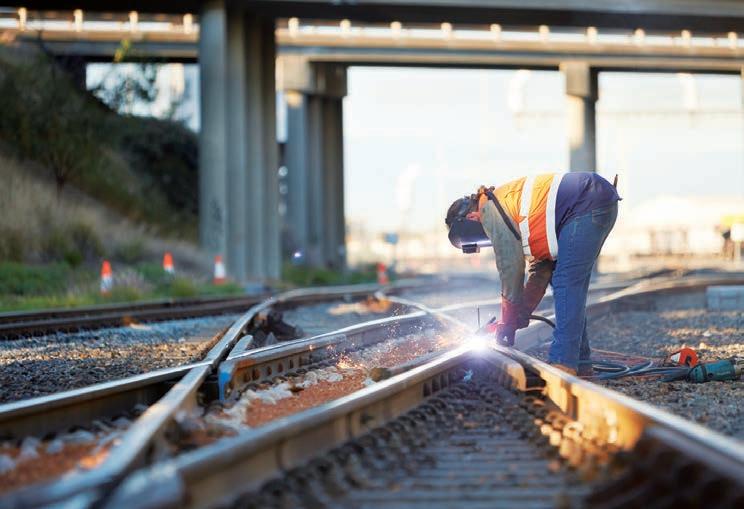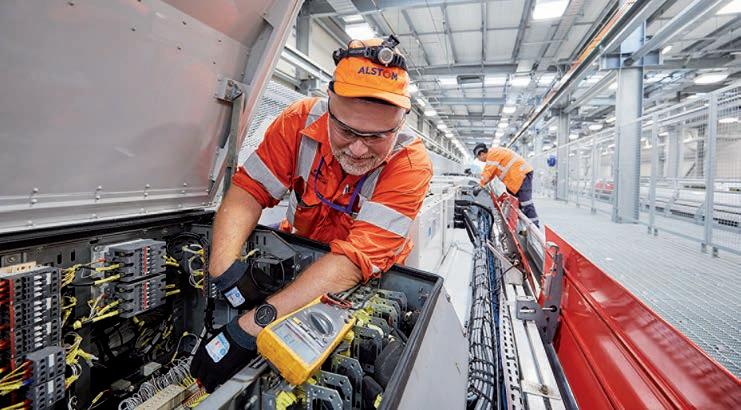
7 minute read
ARA: Survey confirms skills resurgence
Industry Associations
Survey confirms importance of rail skills shortage focus
The Australasian Railway Association’s most recent rail remuneration survey has confirmed key roles remain in demand as the industry continues to address skills shortages.
The latest ARA survey, conducted late last year, predicted rising salaries of up to 4.2 per cent over the next 12 months as the industry continues to advance a range of new projects, technological transformation and innovation.
The survey assessed salary information for 400 rail specific roles across 46 organisations in 2021.
IN-DEMAND ROLES
While the industry is facing a skills shortage across many roles, the survey found that in 2021 rail maintainers and rail trades were most in demand, with total fixed remuneration rising seven per cent over a six-month period.
The increase was attributed to high demand in both rail and other industries, as well as the impact of national skills shortages.
Signals technicians were not far behind, recording an increase of six per cent over the same period, while technical trainers and assurance engineers were expected to be increasingly in demand over the next year.
The survey found WA typically attracted the highest pay for technical roles, partly as a result of additional allowances for remote working.
However, NSW and Victoria attracted premiums for key roles in fields such as health and safety, human resources, technology and project management, as a wave of new projects continued to be delivered.
PREPARING FOR THE PEAK
The survey validates forecasts in the ARA’s Skills Capability Study, which predicted skills shortages for key roles such as signalling technicians, train drivers, train controllers, track workers, trainers and assessors.
The 2018 report predicted a 7.5 per cent workforce gap by 2027 across rail construction, operations and manufacturing.
It anticipated a shortage of 70,000 skilled workers by 2023 – a date that is now almost upon us.
Infrastructure Australia last year confirmed 2023 would present challenges for the infrastructure sector, forecasting shortages would peak next year in its most recent workforce and skills supply report.
International and state border closures over the last two years have exacerbated the challenges faced by the sector, highlighting the importance of addressing this issue to ensure a strong workforce to meet Australia’s long term needs.
As the industry prepares for this peak, the rail construction pipeline has continued to grow, with $155 billion expected to be invested over the next 15 years.
It is clear ensuring the industry attracts and retains the best people in the face of high demand within and beyond the infrastructure sector will require a multi-faceted approach.
The ARA has been working on a range of fronts since the release of its 2018 study.
We continue to contribute to the work of the National Rail Action Plan to support greater collaboration between state governments and industry to address this critical issue.
The progress of three working groups established under NRAP in 2020 was positive and featured strong industry engagement.
We are pleased to see work continues on progressing the working group’s recommendations.
The survey found that in 2021, rail maintainers and rail trades were most in demand. Caroline Wilkie, chief executive, Australasian Railway Association.

WELCOMING NEW PEOPLE TO THE RAIL INDUSTRY
Attracting new people to the industry also remains a focus.
While the industry has fostered a loyal workforce and supports 165,000 direct and indirect jobs, new workers will be needed to meet future demand.
The remuneration survey found more than half of the industry’s talent are Gen X or Baby Boomers, with the average age for people working in rail was 46, about five years older than the national average.
This is part of a broader trend, with Infrastructure Australia predicting 40 per cent of the infrastructure sector’s workforce could potentially retire over the next 15 years.
But there is a new generation moving into the workforce, with the survey finding 41 per cent of rail industry workers were Generation Y, and five per cent Generation Z.
The proportion of women working in rail has also increased, although there remains more room for improvement.
In 2018-19, 27 per cent of the rail workforce were female and 22 per cent of managers were female.
Improving the diversity of the industry will be key to building the rail workforce for the long term, and remains a strong focus for the ARA.
Our next gender diversity report is due for release this year and will help track the industry’s progress and areas for improvement as we continue to promote the industry.
Highlighting the benefits of working in rail will be a key part of the ARA’s program of work this year.
The ARA is currently developing a new Work in Rail campaign, to be released with the launch of a new website later this year, to support industry efforts to attract new people to the industry.
The website responds to industry feedback that there is a need to build awareness about the diversity of roles, and the breadth of rich and rewarding careers, available in rail.
The ARA’s newly formed Work in Rail Project Committee will help lead our work to identify and promote the range of career options available in the industry for school leavers, university graduates and skilled workers from other industries.
This will showcase not just the many rewarding careers available, but the intrinsic community benefits rail has to offer our communities.
The ARA’s Young Leaders’ Advisory Board identified in 2019 that the industry’s contribution to sustainability was a key factor attracting young people to the industry.
Promoting rail careers must therefore also highlight the fact that working in rail contributes to connected communities, takes cars off the road and supports our sustainable development for generations to come.
The benefits of rail have become increasingly clear during the pandemic, as essential rail services have continued to connect people and businesses through lockdowns and restrictions.
Communicating these key benefits must be part of encouraging new people to join our industry and contribute to this important role it plays in the community.

PATHWAYS INTO RAIL
Another area of focus for the industry is highlighting the range of education and training pathways available to work in rail.
Finding training pathways has historically been a challenge for those not already in the industry.
Rail has drawn fewer employees from training provides such as TAFE compared to other industries, with private training providers often meeting the bulk of this need.
This means there has been no rail-specific training available to those not already working in the industry.
Meanwhile, a lack of undergraduate rail units and degree programs have made it challenging to identify clear pathways from engineering and other courses into the rail industry, despite the fact that some of these roles are in high demand.
The ARA is engaging with industry and government to support the development of training and education courses that can help address the rail industry’s skills needs over the medium term, particularly in areas of high demand.
This will be supported by the ARA’s existing work to support national competency matrices to make it easier for rail workers to move between projects and across state borders as they build their careers.
MEETING FUTURE SKILLS NEEDS
There are also great opportunities to attract new people to the industry in emerging roles and relatively new areas of specialisation.
The remuneration survey identified greater investment in sustainability and ESG as the industry increases its focus on sustainable business practices across the supply chain.
The ARA’s Sustainability Committee has confirmed a strong commitment by industry to embed sustainability across its operations, and is working closely with its members to advance a number of initiatives to support our low carbon future.
This will require strong expertise to support sustainability across the rail industry asset lifecycle.
Technology and innovation was also a key focus, with data analytics and automation to drive the industry’s future.
These skillsets will be vital to the industry’s growth over the next decade and beyond, and will help realise greater efficiencies from design and construction through to operations and maintenance.
In additional to ensuring the right training and pathways are in place to attract people that can lead these growth areas, a culture of rail innovation must also be supported at every level of the rail industry.
Smart rail strategies that build the planning pipeline for digital technology will be vital, as will best practice procurement and contracting approaches that accelerate technology adoption.
All these measures will require strong collaboration between industry and government to ensure a national approach to attracting and retaining talented people in the rail industry.
While the immediate challenges require urgent focus right now, there is a great deal of opportunity to harness the intrinsic benefits of rail to build a strong workforce and long and rewarding careers for years to come.
The ARA is engaging with industry and government to address the rail industry’s skills needs in areas of high demand.








